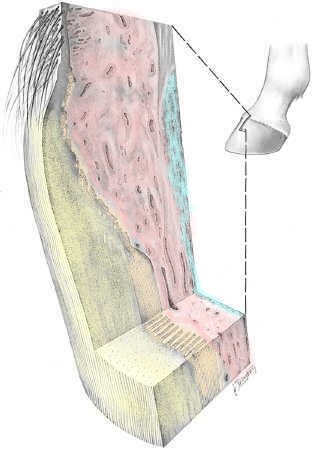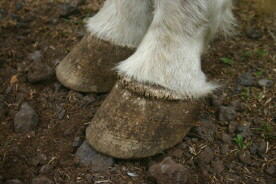Diseases of the Coronary Band of Horses
by Robert N. Oglesby DVM
Introduction
Introduction
»
Symptoms
»
Diagnosis
»
Treatment
»
More Info & Discussions

|
- yellow: Wall Horn
- orange: Laminae
- red: Wall or Lamellar Corium
- blue: Periosteum and bone
span>
|
|
It has a very complicated architecture and injury to the coronet may impair its function......more.
|
The coronary band or coronet is the part of the foot just above the wall and is a modified skin structure that forms the horn of the wall of the foot. Other than trauma and gravels inflammatory diseases of the coronary band is uncommon. Inflammation of the coronet, called coronitis, causes a very distinctive appearance that includes swelling, scaling, and the hair standing out from the coronet.
This article deals with the diagnosis and treatment of inflammatory diseases of the coronary band. For information on punctures and lacerations see,
Coronary Band Trauma in Horses.
Symptoms
Introduction
»
Symptoms
»
Diagnosis
»
Treatment
»
More Info & Discussions
Coronitis often presents with flaking and crusting and in more severe diseases exudation, or ulceration.
Blisters (vesicles), pustules, and necrosis are uncommon. Another common early observation in coronitis is a "winging out," or uplifting of the hair at the coronary band. Chronic coronary band disease may lead to hoof wall defects.
Owners often worry over the white appearance the coronary band takes on in wet conditions. This is caused by increase hydration of the newly developing horn. While not harmful in itself, if it persists for several days it is a indication that a review of the horses environment be made and to see if it would be possible to provide a dryer environment if only for part of the day is possible.
In ruling in primary or secondary disease it is important to note whether the problem is isolated to just the coronets, whether more than one foot is effected, and where did the problem start.
Diagnosis
Introduction
»
Symptoms
»
Diagnosis
»
Treatment
»
More Info & Discussions
To read more on this topic become a member of
Horseadvice.com! Your membership gets you instant access to this and over 600 equine articles on our site. Other benefits of your membership include participation in our discussion boards and access to our one button PubMed search tool for each topic.
Horseadvice.com educates you to be a more knowledgeable horse owner which leads to healthier horses and save you money, we guarantee it. Come Join Us!

